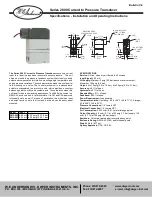
D12
EX-IR
Gas Transmitter with IR Smart Sensor
Dec 2019 ( 85-0004 Rev A)
41
Sensor Calibration
Calibration Frequency
While the transmitter itself requires no periodic calibration, sensors should be “zero” and “span”
calibrated every 3-6 months, based upon environmental factors. Sensors frequently exposed to dirt, oil
mist, vapors, or very dry air, may require more frequent calibration.
Calibration Terminology
The zero calibration is referred to as, “zero”, “zeroing”, and “zeroed”. Likewise for the span calibration,
which appears as, “span”, “spanning”, and “spanned”. As with most instruments, zero calibration should
be performed before span.
Zero Calibration
Zero calibration corrects the reading in the absence of IR absorbing gas. During zero calibration, the
reading is stored in the sensor and subsequently subtracted from future readings. A suitable zero
calibration gas is required, based on the type of sensor. Atmospheric air is usually acceptable for
hydrocarbon gas sensors, but not for CO2 sensors. Bottled “Zero Air” is acceptable for most IR sensors.
Span Calibration
Span calibration corrects the sensor’s sensitivity to a known concentration of target gas (the gas for which
the sensor was designed to monitor). Bottled calibration gas is available for many hydrocarbon and CO2
gases. When target gas readings are scaled from propane (using a k-factor), propane may be selected as a
“surrogate” gas.
Calibration Kits
Calibration kits, containing zero and span bottle gas sources, are available from ATI for many toxic gases.
Contact ATI, or your local ATI representative, if you have questions about calibration gas kits or gas
sources.
Indications During Calibration
The “un-blanked” gas concentration value is displayed during zero and span calibration, primarily to
observe any slight amount of positive or negative drift. Alarms are cleared and inhibited, and the 4-20mA
output is locked at 4.0mA (transmitters equipped with Oxygen sensors are locked at 17.4mA, representing
normal, 20.9% atmospheric Oxygen). The 4-20mA output will not change when gas is applied and
removed, and for 15 minutes thereafter (the default value). While viewing the calibration pages, the LCD
display will indicate the changing gas concentration.
Calibration Exceptions
Zero and span calibration are not allowed during the following conditions:
❖
Sensor removed, or in 5-minute
13
warm-up period
❖
Trouble alarm active
❖
Auto-test active (status indicator appears on Main Display page)
To help prevent errors, zero and span are not allowed if the sensor output, or span value entered, is too
high or too low. If detected, memory errors are reported while updating the sensor or transmitter
memory.
13
Typical value, may vary by sensor gas type.
















































